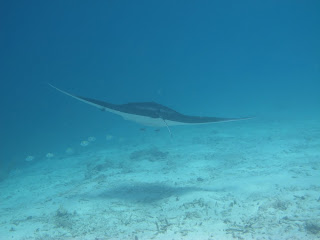


Many species of fish and shrimp act as cleaners, and observing them in action at their cleaning stations is always interesting.
Today we were rather amazed to find a green moray (about 6 feet long), being cleaned by a couple of very small sharknose gobies (less than an inch long). In fact, I couldn't see the cleaners until I looked at my photograph on the computer. The bottom photo is the green moray, and the middle one is a close-up of the goby on it.
For comparison, the top photo is of a bluestriped grunt (about 12 inches long) also being cleaned by a sharknose goby (which was about an inch long).











































